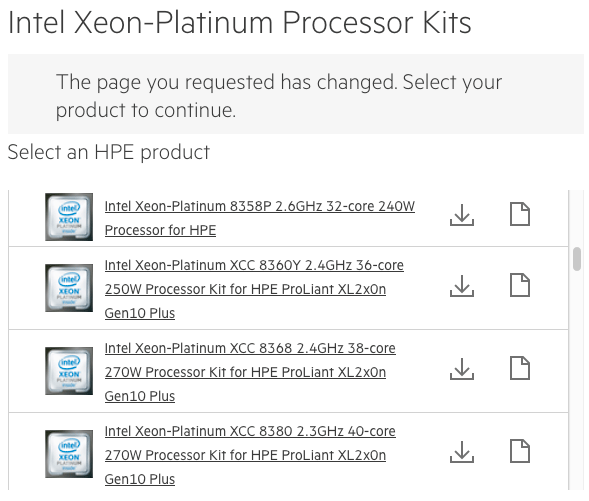HPE Briefly Lists 40-Core Ice Lake CPUs: Intel's Next-Gen HEDT Chips Incoming?
Intel's 40-core Xeon Scalable briefly confirmed by Hewlett Packard Enterprise.
Hewlett Packard Enterprise briefly listed Intel's 3rd Generation Xeon Scalable 'Ice Lake-SP' processors and inevitably revealed their specifications. As spotted by @9550pro, it turns out higher-end extreme core count (XCC) versions of these products will carry up to 40 cores, significantly more than expected a few months ago. For servers, such core count may be considered moderate by today's standards. But how about putting such a 10nm Intel CPU into an extreme desktop or workstation?

One of the things that Intel has not officially disclosed about its next-generation Xeon Scalable 'Ice Lake-SP' processors is their maximum number of cores. Meanwhile, since Intel has been shipping production release qualification (PRQ) versions of its latest yet-to-be-announced server CPUs for several months now, it is hard to keep their specifications under wraps.
Intel's 3rd Generation Xeon Scalable 'Ice Lake-SP' processor family will include a number of processors with more than 28 cores (the maximum number of cores supported by Intel's Cooper Lake CPUs), including the following:
Intel's Ice Lake-SP Processors Listed by HPE
| Model | Frequency | Core Count | TDP |
| Xeon Platinum 8352S | 2.20 GHz | 32-cores | 205W |
| Xeon Platinum 8352Y | 2.20 GHz | 32-cores | 205W |
| Xeon Platinum 8358P | 2.60 GHz | 32-cores | 240W |
| Xeon Platinum XCC 8358 | 2.65 GHz | 32-cores | 250W |
| Xeon Platinum 8352V | 2.10 GHz | 36-cores | 195W |
| Xeon Platinum 8351N | 2.40 GHz | 36-cores | 225W |
| Xeon Platinum XCC 8360Y | 2.40 GHz | 36-cores | 250W |
| Xeon Platinum 8368 | 2.40 GHz | 38-cores | 270W |
| Xeon Platinum XCC 8380 | 2.30 GHz | 40-cores | 270W |
This lineup is certainly not the complete Intel Ice Lake-SP range, but it gives some basic idea about the family.
When compared to AMD's 64-core EPYC 7002-series 'Rome' or 7003-series 'Milan' processors, the 40 cores featured by Intel's Xeon Scalable 'Ice Lake-SP' look relatively pale. Meanwhile, Intel's strength in single-thread performance along with the increased number of cores will make the CPUs more competitive when compared to today's Xeon Scalable offerings.
But what will be particularly interesting is whether Intel intends to use these CPUs for its next-generation processors aimed at high-end desktops as well as extreme workstations. Intel's existing Xeon W-series products are based on the outdated Skylake or Cascade Lake microarchitectures, they feature up to 28 cores, and were launched in 2019. Almost any upgrade to this lineup will inevitably be welcome by PC makers and end-users.
So far, Intel has not confirmed any plans to use its Ice Lake-SP design for HEDTs or workstations, but at least this seems like a reasonable idea keeping in mind that Intel's Sapphire Rapids is at least a year away.
Get Tom's Hardware's best news and in-depth reviews, straight to your inbox.

Anton Shilov is a contributing writer at Tom’s Hardware. Over the past couple of decades, he has covered everything from CPUs and GPUs to supercomputers and from modern process technologies and latest fab tools to high-tech industry trends.